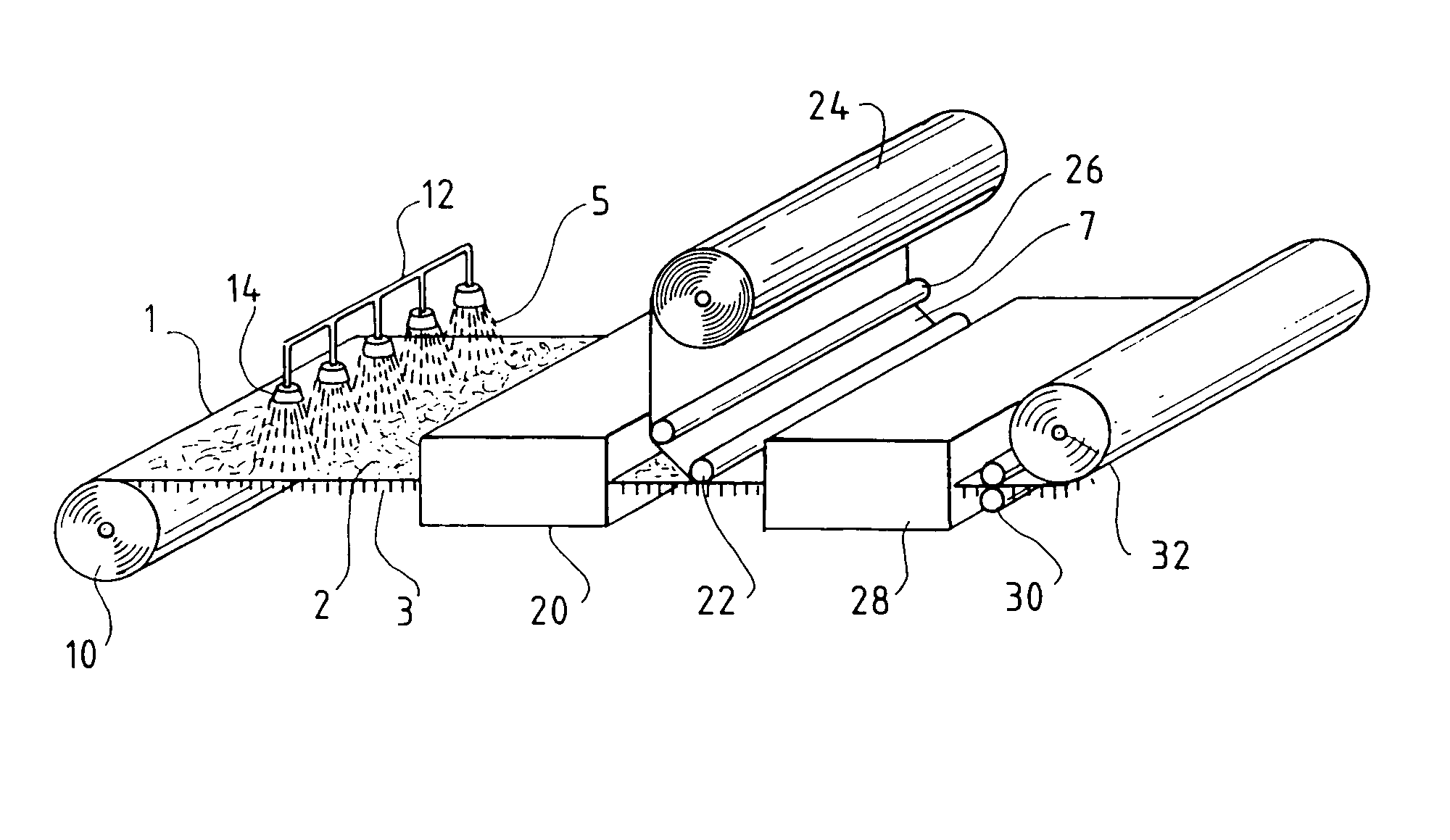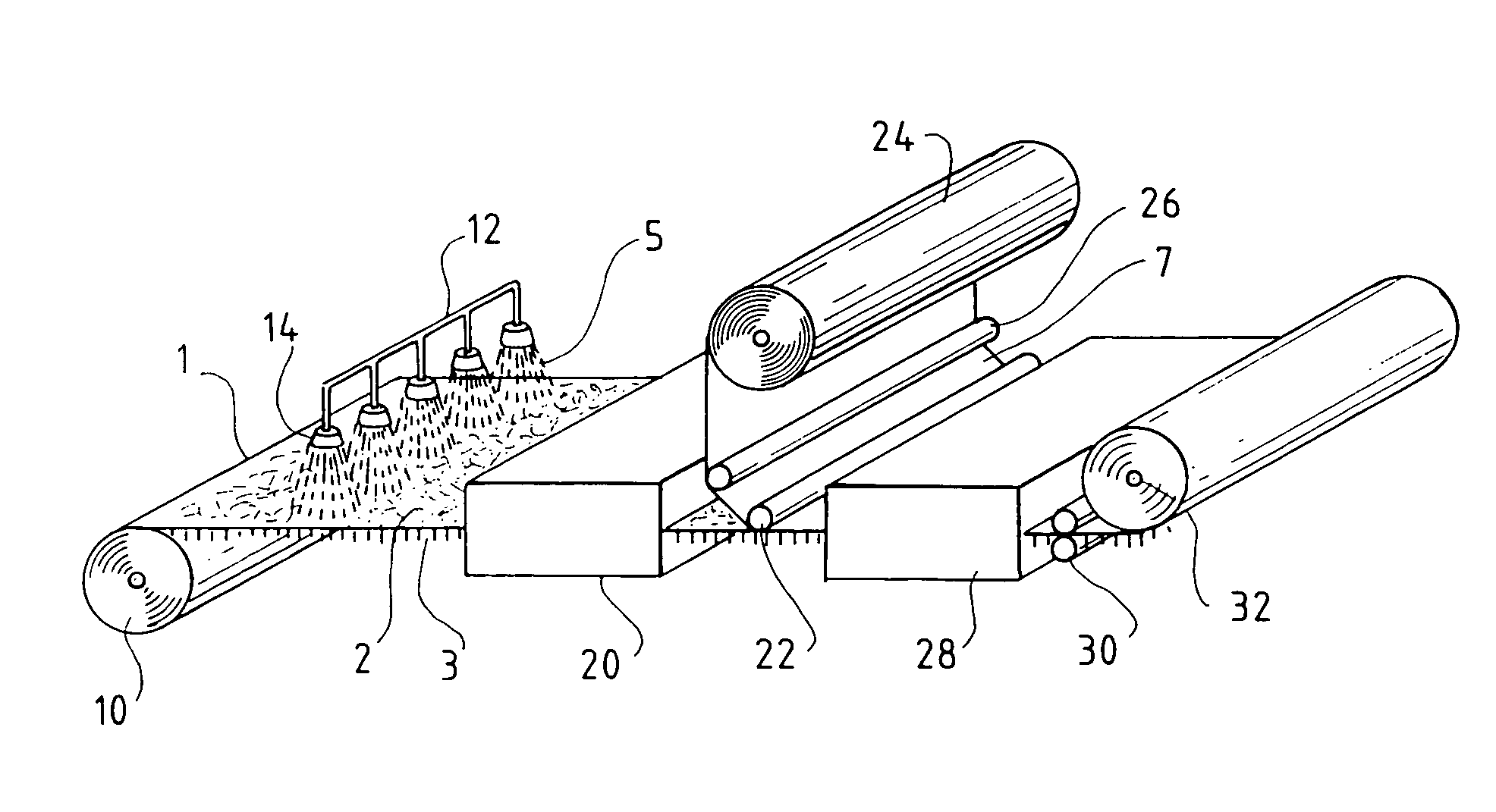[0046]The dramatic improvements in fuzz resistance achieved according to the invention are accomplished with surprisingly low levels of
organic polymer component. Use of the stitch bind composition in amounts providing as little as a fraction of an ounce of organic
polymer component or residue thereof per
square yard of finished carpet can provide significant improvements in fuzz resistance. Another
advantage of the invention is the improved tuft bind that often accompanies the improved fuzz resistance imparted by the organic
polymer component or its residue. Not only do individual filaments of tufts
resist fuzzing better than in known carpets, other things being equal, but tufts are less prone to being pulled out or otherwise removed from finished carpet structures in handling, installation and use. For carpets according to the invention, tuft bind strengths according to ASTM D1335 are often at least about 2 pounds in
cut pile carpets and at least about 5 pounds in loop pile carpets, and preferably greater than 3 pounds and 6.25 pounds, respectively. The form and low levels of stitch bind composition used to achieve such improvements are such that the invented process can be implemented without complicated and expensive equipment additions or modifications. Further, carpets according to the invention have the
water resistance benefits of thermoplastic binders and the potential for recycle by melt
processing.
[0047]Carpets according to the invention, when constructed from thermoplastic backings and face yarns, are advantageous by reason of their potential for reuse in plastics reprocessing operations. As noted above, use of thermoplastic binders, as opposed to conventional latexes, avoids the crosslinked latex particles that typically result from curing conventional latexes and, in turn, difficulties they cause in attempts to reprocess the same in melt fabrication processes. Consequently, not only trim and waste from carpet
manufacturing operations, but even post-
consumer carpet are more easily used in recycle operations in which
plastic waste is reduced to a form and size suitable for use in
extrusion, molding,
spinning or other melt
processing operations and so-processed either alone or blended with virgin or other plastics recycle streams. Preferred organic polymer components of the invented carpets are processible with plastics from backings, face yarns and thermoplastic binders in melt reprocessing operations, and even in the case of organic polymer compositions normally considered incompatible or ill-suited for such operations, the levels used or present for achieving improved fuzz resistance are often low enough that they do not impair reprocessing. The invented carpets and process also afford opportunities for avoiding the expense of recycle operations in which pile surfaces are sheared to remove face yarn tufts for reuse of the plastics thereof, and for disposal of backings and binders through use in melt reprocessing operations even when pile surfaces are sheared.
[0048]The benefits of the invented carpets provide opportunities to expand utility of carpets with thermoplastic binders to a broader range of applications, many of which have been considered beyond the reach of such carpets due to their demanding requirements. Specific examples include commercial carpets, such as are used in office buildings, airports, schools and the like, and hospitality carpets, such as hotel and motel carpeting, all of which are subject to heavy wear due to extensive and rigorous traffic, frequent cleaning and sometimes careless or inattentive use. Benefits of the invention can be realized over the entire life of a carpet, including greater potential for reuse of carpet materials during manufacture, easier and less labor-intensive installation due to the carpets' lower weights, expanded
cold weather and
cold climate installability due to their greater flexibility, better appearance during use and longer useful life due to reduced fuzzing and retention of tuft lock when exposed to water, and the potential for melt reprocessing instead of disposal at the end of the carpet's life.
[0049]As described above, in one of its aspects the invention provides a process for manufacture of carpets using thermoplastic binders to anchor tufts of face yarn to or between backings wherein improved retention of filaments of the tufts is achieved through use of a stitch bind composition that is applied to the stitches of a tufted backing and bonds filaments of a plurality of stitches so that they are more resistant to being removed from the tufts that form the carpet pile. The process and the improved carpet performance it provides are broadly applicable in manufacture of carpets in which stitches of face yarn are anchored to a backing or between backings by cooling a thermoplastic binder comprising softened or melted thermoplastic resin in contact with the stitched side of a tufted backing or between such a stitched side and an additional backing. Such processes can vary considerably in their specific aspects but they preferably comprise basic steps that involve providing a tufted backing having a pile side comprising face yarn tufts and a stitched side having face yarn stitches, contacting the stitched side of the tufted backing with a thermoplastic binder comprising a thermoplastic resin capable of being softened in contact with the tufted backing, or of being softened and then contacted with the tufted backing, without damage to the tufted backing, heating the thermoplastic binder to soften the resin without damaging the tufted backing, and cooling the binder with the softened resin thereof in contact with the stitched side of the tufted backing to solidify the resin. When an additional backing is to be bonded to the stitched side of the tufted backing in such processes, the processes include a step in which the additional backing, thermoplastic binder and tufted backing are contacted to form an
intermediate structure in which the binder is disposed between the stitched side of the tufted backing and the additional backing, and a step in which the
intermediate structure with the thermoplastic resin of the thermoplastic binder in softened form is cooled to solidify the resin. The improvements according to the present invention result from including in such processes, before the softened resin of the thermoplastic binder solidifies, steps comprising applying to a plurality of the stitches a stitch bind composition comprising an organic polymer component capable of bonding filaments of the stitches and a liquid carrier for the organic polymer component that can be removed by heating without damaging the tufted backing, and heating the stitch bind composition, after application thereof, to remove the liquid component without damaging the tufted backing.
[0050]Thus, in some of its embodiments, the process according to the invention may be considered an improvement that is applicable to a wide range of processes for carpet manufacture utilizing thermoplastic binders. In other embodiments, the invention resides in processes for manufacture of carpets in which particular steps or aspects or combinations thereof provide new and improved results. The drawing illustrates an embodiment of a process according to the invention. While the process is susceptible, without departing from the scope of the invention, to variation in its steps, their sequence, materials used therein and in other respects, the drawing and the following description thereof will contribute to understanding of both the particular embodiment exemplified in the drawing and of various broader aspects of the invention.
[0051]In the process illustrated in the drawing, stitch bind composition is applied to a stitched side of a tufted backing, the backing with applied stitch bind composition is heated to remove the liquid component, the result is contacted with a thermoplastic binder and then heated to soften or melt the resin of the binder, and the stitched side of the backing in contact with the softened or melted resin of the binder is cooled to solidify the resin. Referring to the drawing, tufted backing 1, comprising a backing having a pile formed from face yarn tufts extending therefrom on pile side 3 and face yarn stitches disposed on an opposite, stitched side 2 is unwound from roll 10. The tufted backing, with its stitched side up and pile side down, is advanced past applicator 12 at which stitch bind composition 5, in liquid form, is applied to the stitched side into contact with a plurality of stitches across the width of the tufted backing. Applicator 12 has spray heads 14 configured to apply a spray to the stitched side across its width as the tufted backing advances. The applicator includes a reservoir and associated controls, pump and transfer lines (not shown) for holding the stitch bind composition and delivering it to the nozzles under pressure adequate to form a spray. The stitch bind composition is a solution, suspension or
emulsion comprising organic polymer and liquid components. The composition is formulated with a
viscosity effective for
coating or penetrating the stitches and organic polymer content effective for bonding filaments of the stitches after the liquid component is removed.
 Login to View More
Login to View More 

